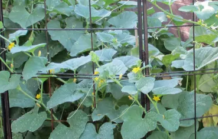https://hnr.k-state.edu/extension/info-center/newsletters/index.html
Blog Post: http://www.ksuhortnewsletter.org
Video of the Week: https://kansashealthyyards.org/all-videos/video/when-to-pick-tomatoesComposting: Making Black Gold
https://kansashealthyyards.org/all-videos/video/composting-making-black-gold
UPCOMING EVENTS
The Kansas Turf & Ornamental Field Day will be held Thursday, August 4 at the John C. Pair Horticulture Research Center (1901 E. 95th St. S., Haysville, KS)
The field day program is designed for all segments of the turf & ornamentals industry – lawn care, athletic fields, golf courses, landscape, nursery, and grounds maintenance. Included on the program are research presentations, problem diagnosis, commercial exhibitors, and equipment displays. There will be time to see current research, talk to the experts and get answers to your questions.
One hour of pesticide recertification credit in both 3A and 3B are available, as well as GCSAA education points.
For more information, go to www.kansasturfgrassfoundation.com, or you can register online at https://2022turfday.eventbrite.com
REMINDERS
• Divide iris if needed.
• Do not fertilize the warm-season turfgrasses, buffalograss, zoysiagras and bermudagrass, past August 15. Doing so may increase the chances for winter damage.
• Check mulch layers and add additional material if needed.
VEGETABLES
Still Time for a Salad Garden
Plant salad crops such as lettuce, radishes, spinach, turnips, mustard and other greens from mid-August to early September for a fall harvest. Plant slightly deeper than you did in the spring. This will keep the seed slightly cooler though still warm and the soil should retain moisture longer. Water frequently (if needed) until seedlings start to emerge — which should be fast with our warmer soils. Watering heavy soils can sometimes cause a crust to form. This can be prevented by a light sprinkling of peat moss, vermiculite or compost directly over the row. Reduce watering frequency after plants emerge. Plants may need to be protected from hungry rabbits and insects. (Ward Upham)
FRUIT
When Are Apples Ready to Pick?
Apples mature over a long period of time depending on variety. Some varieties such as Lodi can mature in July and others as late as October or even November. Here are some guides to help you decide when to pick your apples.
Days from bloom: The number of days from bloom is a reliable guide for general maturity time, but weather conditions will have some influence. Some kinds of apples and approximate days from bloom to maturity are Jonathan, 135, Delicious, 145, Golden Delicious, 145, and Winesap,155 days.
Flesh color: As apples mature and starches change to sugars, the flesh changes from very light green to white. When you cut a thin slice and hold it up to the light you can see the difference.
Seed color: The seeds of most apples change from light green to brown as the fruit ripens. This indicator should be combined with other changes since it is not absolute. The flavor of the apples, the change in color of the stem and calyx basins and flesh color are important in deciding if apples are ready to harvest.
Color change: As apples mature, the skin color in areas of the stem and the calyx basin at the bottom of the apple turns from an immature green to a light-yellow color. Some apples will develop a red skin color over the majority of the fruit before they are ripe, so this is not a reliable indication of maturity.
Flavor: This is a good guide if you are familiar with the apples you have and know how they should taste. Even if you do not know the characteristic flavor of the kind of apple you have, you can still sample slices of a few apples and decide if they have a sweet flavor. If they are not ready to harvest, they will taste starchy or immature. If apples have already fallen and taste a bit starchy, store them for a period to see if they become sweeter. (Ward Upham)
Fertilize Strawberries
Early- to mid-August is the time to fertilize strawberries in order to increase the number of fruit produced next spring. Plenty of daylight and warm temperatures during June, July and August promotes the growth of new runner, or daughter, plants. As daylight hours dwindle and temperatures grow cooler in September and October, fruit buds for the next year’s fruit crop develop. To get a good berry crop next spring, it is important for strawberry plants to be vigorous during this period of fruit bud development.
Nitrogen, applied now, will help promote fruit bud development. A general application rate is ½ to 3/4 pound of actual nitrogen per 100 feet of row. The nitrogen may be in the form of a fertilizer mixture such as ammonium phosphate or 12-12-12, or in a fertilizer containing only nitrogen such as urea or ammonium nitrate. Some specific examples would include:
Iron + (11-0-0) at 6 pounds per 100 feet of row.
12-12-12 at 5.5 pounds per 100 feet of row.
Nitrate of Soda (16-0-0) at 4 pounds per 100 feet of row
Ammonium sulfate (21-0-0) at 3 pounds per 100 feet of row
Urea (46-0-0) at 1.5 pounds per 100 feet of row
As a general rule, each cup of fertilizer weighs ½ pound. On sandy soils, the rate may be increased by about a half.
After spreading the fertilizer, water the area applying at least a half-inch of water to move the nitrogen into the strawberry root areas. (Ward Upham)
PESTS
Mimosa Webworm on Honeylocust
Honeylocust trees in some parts of Kansas are browning due to mimosa webworm. Damage is caused by the larvae, which mat leaves together with webbing and use them as a nest. These nests are normally found on the tips of branches and appear as brown areas from a distance. Closer inspection reveals the white webbing. Mature larvae are 0.5 inches long, light green to dark brown and sport five longitudinal white stripes.
The adults are silvery gray moths with small black spots on the wings. Mimosa webworm can severely defoliate trees. However, if the damage occurs late (such as now), healthy trees are not significantly harmed. Also, it’s late enough in the season that spraying will not help the trees. If mimosa webworm is a yearly problem on your honeylocusts, apply an insecticide such as BT (Dipel or Thuricide) or spinosad. Spinosad is found in Natural Guard Spinosad, Captain Jack’s Deadbug Brew, Bonide Colorado Potato Beetle Beater and Monterey Garden Insect Spray. Both of these products are organic controls. Traditional controls that contain cyfluthrin or bifenthrin are also effective. However, any of these products must be applied earlier in the year when you first notice webbing. (Ward Upham)
MISCELLANEOUS
Plants for Late Season Bloom
Landscapes are often drab this time of year. You can add interest to your home by planting shrubs this fall or next spring that flower later in the growing season. Consider one or more of the following.
Rose of Sharon (Hibiscus syriacus) is a tall shrub that produces single or double flowers. Colors range from white to red, purple or violet, or combinations, depending on the variety.
Crapemyrtle (Lagerstroemia indica) are dwarf-to-tall shrubs or trees. They are not reliably winter hardy in Kansas and often die back to the ground. Crapemyrtle flowers on new wood, so plants pruned (or killed) to the ground while dormant in late winter or early spring will bloom later the same year. Flower color varies from white, pink, to purple or deep red on different plants.
Bluebeard (Caryopteris x clandonensis) is also known as blue-spirea, blue-mist shrub, or caryopteris. It usually is found with blue flowers, but some cultivars have a bluish-violet to violet flower color. Plants are usually cut back in late winter or early spring. Flowers are borne on the current season’s growth.
Sweet Autumn clematis (Clematis terniflora) is a vigorous vine with large masses of small, white flowers that have a wonderful fragrance. Be careful with this one; it can easily outgrow its bounds. It is often a good idea to cut it back to the ground in early spring.
Davidiana clematis (Clematis heracleifolia var. Davidiana) is a bush-type clematis with small but interesting violet-blue flowers. Female plants bear interesting fluffy seed heads into the
winter. This clematis needs to be cut back to the ground each year to help maintain the shape of
the plant.
The PeeGee hydrangea (Hydrangea paniculata Grandiflora) is a somewhat coarse plant that develops large clusters of white flowers. It can be trained into a tree-like form. (Ward Upham)
Composting: The Science
Composting is a process whereby you can turn trash into treasure by recycling garden waste and kitchen scraps into humus that can improve soil structure and act as a fertilizer.
Microorganasims drive this process and are composed of bacteria, actinomycetes and fungi. Bacteria are composed of three different types that work best and different temperature ranges. Psychrophilic bacteria start the composting process and prefer the lowest temperature range and are most active at 55 degrees F. Their activity produces a small amount of heat so that the mesophilic bacteria can take over. Mesophilic bacteria prefer a temperature within the pile of 70 to 100 degrees. They are followed by the most heat-loving bacteria which are the thermophilic bacteria. They thrive at temperatures between 113 to 160 degrees F. These microorganisms die when they finish digesting the material in the pile and the temperature drops.
Actinomycetes are a special bacteria that are similar to fungi and molds. They are important as they help decompose some of the more resistant materials such as lignin and cellulose. They work best at moderate temperatures.
Fungi are less heat resistant and prefer temperatures between 70 and 75 degrees F. They are compost “finishers” and are most active after the other microorganisms are done.
So the compost pile goes through a process whereby the compost pile starts cool, builds up to a high temperature and then cools. Next week we will look at what we need to make a compost pile. For more information on compost pile microbes, see https://www.calrecycle.ca.gov/organics/homecompost/microbes (Ward Upham)
Contributors: Ward Upham, Extension Associate
Division of Horticulture
1712 Claflin, 2021 Throckmorton
Manhattan, KS 66506
(785) 532-6173
For questions or further information, contact: wupham@ksu.edu OR cdipman@ksu.edu
This newsletter is also available on the World Wide Web at:
http://hnr.k-state.edu/extension/info-center/newsletters/index.html
The web version includes color images that illustrate subjects discussed. To subscribe to this newsletter electronically, send an e-mail message to cdipman@ksu.edu or wupham@ksu.edu listing your e-mail address in the message.
Brand names appearing in this newsletter are for product identification purposes only. No endorsement is intended, nor is criticism implied of similar products not mentioned.
K-State Research and Extension is committed to making its services, activities and programs accessible to all participants. If you have special requirements due to a physical, vision or hearing disability, or a dietary restriction please contact Extension Horticulture at (785) 532-6173.
Kansas State University Agricultural Experiment Station and Cooperative Extension Service K-State Research and Extension is an equal opportunity employer. Issued in furtherance of Cooperative Extension Work, Acts of May 8 and June 30, 1914, as amended. Kansas State University, County Extension Councils, and United States Department of Agriculture Cooperating, Ernie Minton, Dean.





